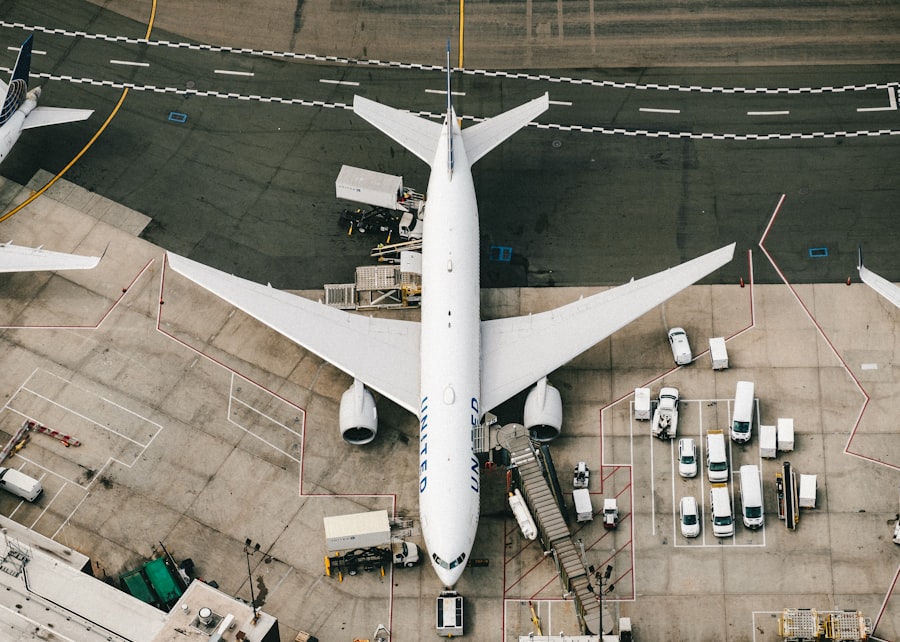Oman’s aviation industry has emerged as a significant player in the Middle East, characterized by its strategic geographical location, which serves as a bridge between the East and West. The country’s commitment to developing its aviation sector is evident in its investments in infrastructure, regulatory frameworks, and partnerships with international airlines. The Sultanate of Oman has recognized the potential of aviation not only as a means of transportation but also as a catalyst for economic diversification and growth.
This sector is pivotal in connecting Oman to global markets, enhancing trade, and promoting tourism, thereby contributing to the overall development of the nation. The aviation landscape in Oman is shaped by a combination of government initiatives and private sector participation. The government has established a robust regulatory environment that encourages investment and innovation while ensuring safety and security standards are met.
This proactive approach has attracted foreign airlines and investors, fostering a competitive atmosphere that benefits both consumers and businesses. As Oman continues to develop its aviation capabilities, it is poised to play an increasingly vital role in the regional and global aviation markets.
Key Takeaways
- Oman’s aviation industry has experienced significant growth and development in recent years, positioning itself as a key player in the global aviation market.
- The growth and development of Oman’s airports have been instrumental in enhancing the country’s connectivity and accessibility, attracting more tourists and business travelers.
- Oman Air plays a crucial role in the country’s aviation industry, contributing to the growth of tourism and business activities through its extensive network and high-quality services.
- Tourism has had a significant impact on Oman’s aviation sector, driving the demand for air travel and leading to the expansion of airport infrastructure and services.
- Cargo and logistics play a vital role in Oman’s aviation industry, supporting the country’s trade and economic activities while contributing to the overall growth of the sector.
The Growth and Development of Oman’s Airports
The growth of Oman’s airports has been remarkable over the past few decades, reflecting the country’s ambition to enhance its connectivity and infrastructure. Muscat International Airport, the primary gateway to Oman, has undergone significant expansions and upgrades to accommodate increasing passenger traffic and modernize its facilities. The airport’s expansion project, which was completed in 2018, increased its capacity to handle over 20 million passengers annually.
This transformation not only improved the passenger experience with state-of-the-art amenities but also positioned Muscat as a competitive hub in the region. In addition to Muscat International Airport, other airports across Oman have also seen substantial development. Salalah Airport, serving the southern region of Oman, has been upgraded to enhance its capacity and services, catering to both domestic and international flights.
The government has invested in regional airports such as Duqm Airport and Sohar Airport, which are crucial for promoting economic activities in their respective areas. These airports are designed to support not only passenger travel but also cargo operations, thereby facilitating trade and commerce. The strategic development of these airports underscores Oman’s commitment to creating a comprehensive aviation network that supports its economic diversification goals.
The Role of Oman Air in the Country’s Aviation Industry

Oman Air plays a pivotal role in shaping the aviation landscape of Oman, serving as the national carrier and a key player in connecting the country to international destinations. Established in 1993, Oman Air has grown from a modest airline into a significant regional carrier with a fleet that includes modern aircraft equipped with advanced technology. The airline’s strategic focus on quality service and customer satisfaction has earned it recognition in the competitive aviation market.
With routes extending across Asia, Europe, and Africa, Oman Air not only facilitates travel for tourists but also serves as a vital link for Omani expatriates living abroad. The airline’s commitment to sustainability and innovation is evident in its operational practices. Oman Air has invested in fuel-efficient aircraft and implemented various initiatives aimed at reducing its carbon footprint.
Furthermore, the airline has embraced digital transformation by enhancing its online services and customer engagement platforms. This focus on modernization aligns with Oman’s broader vision of becoming a leading player in the global aviation industry. By fostering partnerships with other airlines and participating in global alliances, Oman Air is positioning itself as a competitive force that can adapt to changing market dynamics while contributing to the growth of Oman’s aviation sector.
The Impact of Tourism on Oman’s Aviation Sector
| Year | Number of Tourists | Passenger Traffic | Number of Flights |
|---|---|---|---|
| 2015 | 2.1 million | 10.5 million | 68,000 |
| 2016 | 2.5 million | 12.3 million | 75,000 |
| 2017 | 3.2 million | 15.6 million | 82,000 |
| 2018 | 3.5 million | 17.8 million | 90,000 |
| 2019 | 3.9 million | 19.5 million | 95,000 |
Tourism is a cornerstone of Oman’s economy, significantly influencing the growth of its aviation sector. The country’s rich cultural heritage, stunning landscapes, and diverse attractions have made it an appealing destination for travelers from around the world. As tourism continues to flourish, the demand for air travel has surged, prompting airlines to expand their services to meet this growing need.
The government’s efforts to promote tourism through initiatives such as the Oman Tourism Strategy 2040 have further bolstered this trend, leading to increased flight frequencies and new routes being introduced by both Oman Air and international carriers. The impact of tourism on Oman’s aviation sector extends beyond passenger numbers; it also stimulates economic activity across various sectors. Increased air traffic leads to higher hotel occupancy rates, boosts local businesses, and creates job opportunities within the hospitality and service industries.
Moreover, the influx of tourists contributes to cultural exchange and enhances Oman’s global profile as a travel destination. The synergy between tourism and aviation is evident in various events hosted in Oman, such as international conferences and festivals that attract visitors from around the globe, further solidifying the importance of air travel in supporting the tourism sector.
The Importance of Cargo and Logistics in Oman’s Aviation Industry
Cargo and logistics play a crucial role in Oman’s aviation industry, serving as a backbone for trade and commerce within the region and beyond. With its strategic location along major shipping routes, Oman has positioned itself as an essential hub for cargo operations. The development of specialized cargo facilities at airports like Muscat International Airport has enhanced the country’s capacity to handle freight efficiently.
These facilities are equipped with advanced technology for tracking shipments, ensuring timely delivery while maintaining high standards of safety. The logistics sector in Oman is further supported by initiatives aimed at improving infrastructure and connectivity. The establishment of free trade zones and logistics parks has attracted businesses looking to capitalize on Oman’s advantageous location for distribution purposes.
Additionally, partnerships with international logistics companies have facilitated knowledge transfer and best practices in cargo handling. As e-commerce continues to grow globally, Oman’s aviation industry is well-positioned to leverage this trend by expanding its cargo services and enhancing its logistics capabilities, thereby contributing significantly to the national economy.
The Future of Oman’s Aviation Industry: Challenges and Opportunities

As Oman’s aviation industry looks toward the future, it faces both challenges and opportunities that will shape its trajectory. One of the primary challenges is navigating the competitive landscape of regional airlines that are vying for market share. Neighboring countries have made significant investments in their aviation sectors, leading to increased competition for passengers and cargo traffic.
To remain competitive, Oman must continue to innovate and enhance its services while maintaining cost efficiency. On the other hand, opportunities abound for Oman’s aviation industry as it seeks to diversify its economy away from oil dependency. The government’s Vision 2040 initiative emphasizes economic diversification through sectors such as tourism, logistics, and manufacturing—all of which rely heavily on robust air transport networks.
By capitalizing on these opportunities, Oman can position itself as a leading hub for trade and tourism in the region. Furthermore, advancements in technology present avenues for improving operational efficiency and customer experience within the aviation sector.
Oman’s Aviation Industry in the Global Context
In the global context, Oman’s aviation industry is increasingly recognized for its potential to contribute to regional connectivity and economic development. As international travel rebounds post-pandemic, Oman stands at a crossroads where it can leverage its unique geographical position to attract more airlines and travelers. The country’s commitment to safety standards and regulatory compliance aligns with global best practices, making it an attractive destination for international carriers looking to expand their networks.
Moreover, Oman’s participation in global aviation forums and partnerships with international organizations enhances its visibility on the world stage. By engaging with stakeholders from various countries, Oman can share insights and learn from best practices that can be applied within its own aviation sector. This collaborative approach not only strengthens Oman’s position within the global aviation community but also fosters relationships that can lead to increased investment opportunities and joint ventures.
The Potential for Further Growth in Oman’s Aviation Sector
The potential for further growth in Oman’s aviation sector is substantial, driven by strategic investments in infrastructure, regulatory frameworks that encourage innovation, and a commitment to enhancing connectivity through both passenger travel and cargo operations. As Oman continues to diversify its economy away from oil dependency, the aviation industry will play an integral role in supporting this transition by facilitating trade, tourism, and logistics. With ongoing developments at airports across the country and a focus on sustainability within airlines like Oman Air, there is a clear path forward for growth.
By embracing technological advancements and fostering partnerships within the global aviation community, Oman can position itself as a key player in shaping the future of air travel in the Middle East and beyond. The synergy between tourism, logistics, and air transport will undoubtedly propel Oman’s aviation sector into new heights of success in the coming years.


